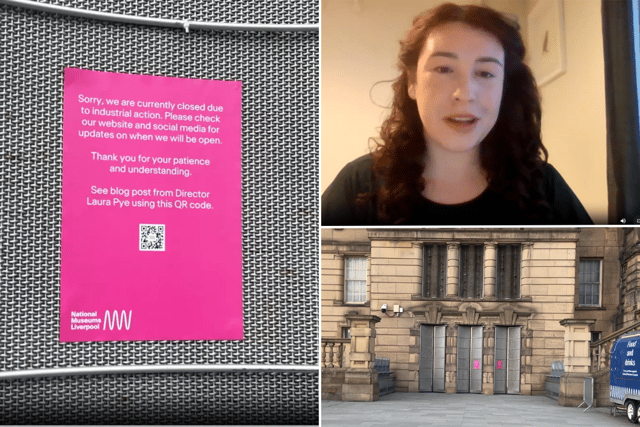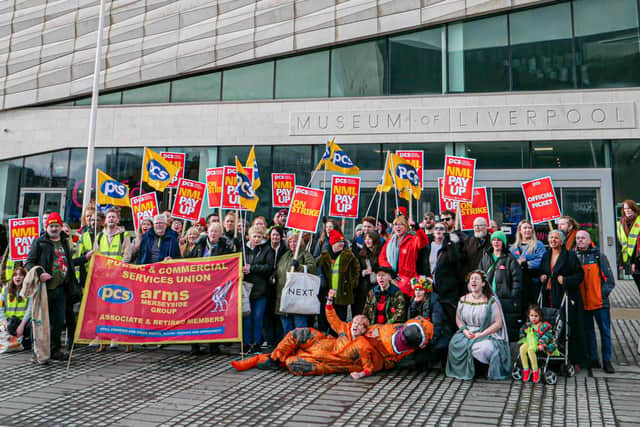Seven Liverpool museums and galleries close as lengthy strike begins - full list and strike dates
and live on Freeview channel 276
More than 200 Merseyside museum workers have started eight weeks of strike action over a disputed £1500 cost-of-living crisis payment from National Museums Liverpool (NML).
The industrial action began at the weekend and will continue to affect the Museum of Liverpool, World Museum, International Slavery Museum, Maritime Museum, Sudley House, Lady Lever Art Gallery and the Walker Art Gallery. The period for industrial action is due to end on 14 April.
Advertisement
Hide AdAdvertisement
Hide AdAn offer on Friday (16 February) morning by the Public and Commercial Services (PCS) union to receive the £1,500 cost-of-living payment in two instalments was turned down by museum staff, ending hopes the dispute could have been resolved before strike action started.
Leila Gwynne works at NML and is taking part in the industrial action; she told LiverpoolWorld: "Ultimately, decisions have been made to spend money elsewhere. We would argue that they’ve had several months to come up with a solution and to reconsider, and they simply haven’t. A colleague said, we’ve got priceless artefacts inside, but it’s all staff that are the truly priceless things in the museums."


Director of National Museums Liverpool Laura Pye said strike action is 'deeply regrettable' and wants to get round the table with union chiefs to resolve the dispute. Writing on the NML website, she said: “National Museums Liverpool is a not-for-profit organisation which has been impacted in the same ways as many other arts organisations over the last four years.
"We’re not a private corporation producing a financial return for stakeholders, and while we do receive a substantial grant from the Department of Culture, Media and Sport (DCMS), as an arms-length body organisation, we’re not fully funded by them.
Advertisement
Hide AdAdvertisement
Hide Ad“We work hard to raise additional funds to support all our brilliant programmes of activity through targeted fundraising and, whilst we remain free to access, via much-valued support of visitors through our cafes, shops and paid-for experiences."
Ms Pye, who has been at the head of NML since 2018, said the organisation understood 'the importance of fair remuneration for the hard work and loyalty' staff give. She added: “Before the pandemic, we committed to a comprehensive pay and conditions review, which considers how we can move to a fair and equal system of pay, holidays, flexible working and pensions – the things that colleagues had said were important to them through our annual engagement survey.”
The director said staff salaries had increased by an average of 14% over the last four years while being impacted by “some of the highest inflation we have seen in years, hugely increased energy bills, and our visitor figures are still 10% lower than pre-pandemic levels. In this same period, we’ve seen our grant from DCMS increase by 4%.”
Ms Pye added: “We’ve never planned a one off non-consolidated payment, and all the funding we had available was put into consolidated rises, prioritising our lowest paid colleagues. Ultimately, making a one-off payment of £1,500 on top of what we’ve implemented and committed, is simply unaffordable to us as an organisation, and would threaten the long-term sustainability of your museums and galleries.”


Advertisement
Hide AdAdvertisement
Hide AdLast year, more than 130,000 PCS union members - including those working at NML - took strike action over pay, which resulted in a rise of at least 4.5% and the promise of a one-off £1,500 cost-of-living crisis payment.
The NML say the one-off cost of living payment was part of a government agreement which covered a number of years, including one year when the Civil Service froze pay. However, NML says it is not part of the Civil Service pay remit, and therefore people in NML are not civil servants. The PCS claim the NML is the only one of 207 employers not to have yet honoured the £1,500 payment or equivalent. However, NML say that of the 15 National Museums services, they are one of 10 organisations that have not been able to deliver the cost-of-living crisis payment on top of the pay awards agreed. You can read a more detailed response here.
On the first day of the strike on Saturday (17 February), around 70 striking members were on the picket line, with many dressed in historic costumes to represent museum exhibits, including Greek gods, suffragettes and even a dinosaur, the PCS said. The museum workers have created a schedule of themed picket lines for the next few weeks, that will include activities for the public. All will be at the Museum of Liverpool at Pier Head from 8-11am.
Themed picket lines
- Tuesday 20 February – Return of the dogs, bring along your four-legged best friend.
- Wednesday 21 February – Super Scouse Disco – Festival vibes in sequins, even if it rains.
- Thursday 22 February – Party on the Pierhead, bring along lawn games, skipping ropes etc. Children welcome.
- Friday 23 February – Art for All, artists will be on the picket line to help you get sketchy and creative.
- Saturday 24 February -Make some noise – a rally with speakers and music.
The Museum of Liverpool say that their café and shop are open as usual and that the museum plans to re-open on Thursday 22 February. However, the strike situation can change from week to week and visitors are advised to check the websites of National Museums Liverpool venues for updates.
Watch the video above for our full feature of the museum strikes and to hear more from Leila Gwynne from National Museums Liverpool.